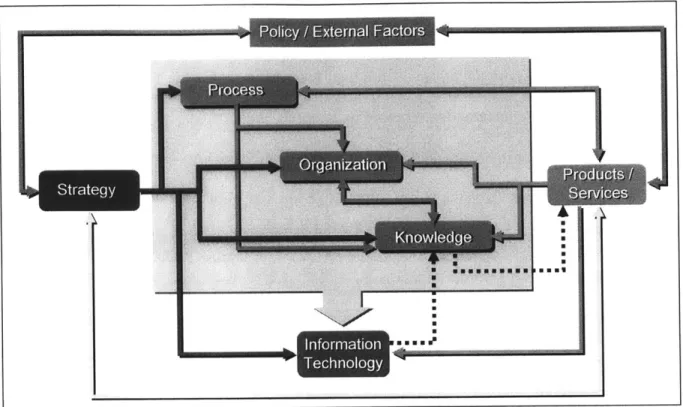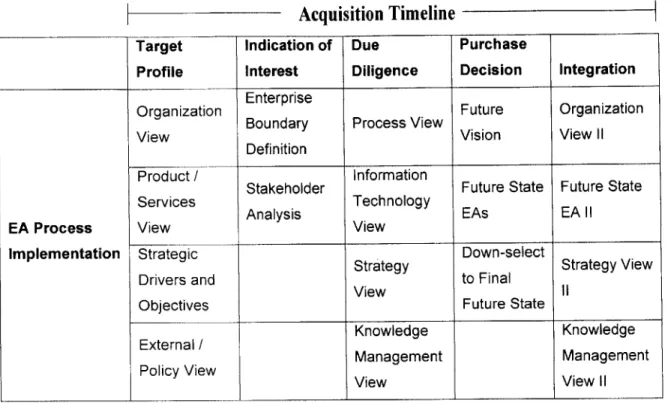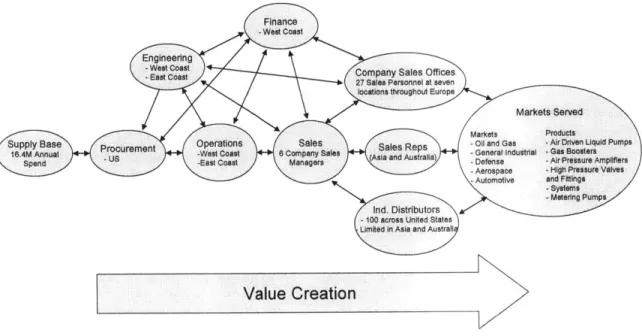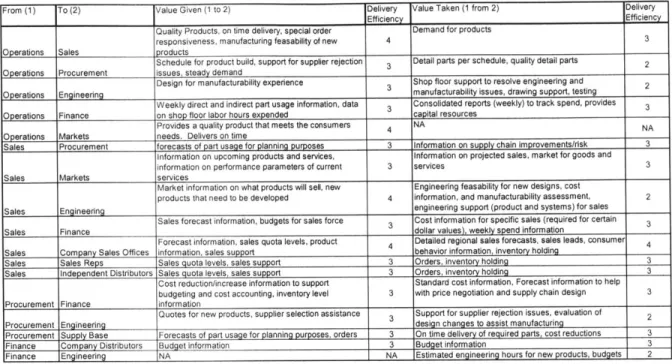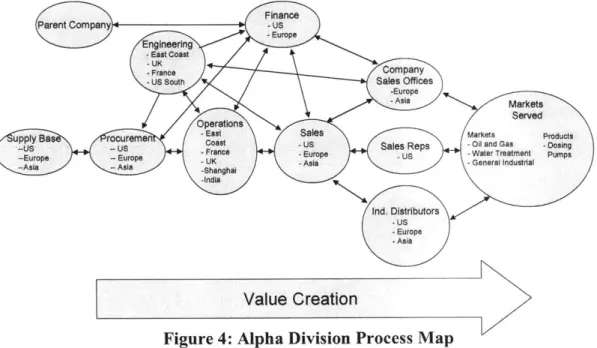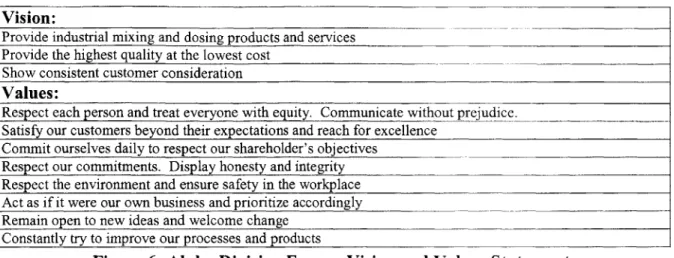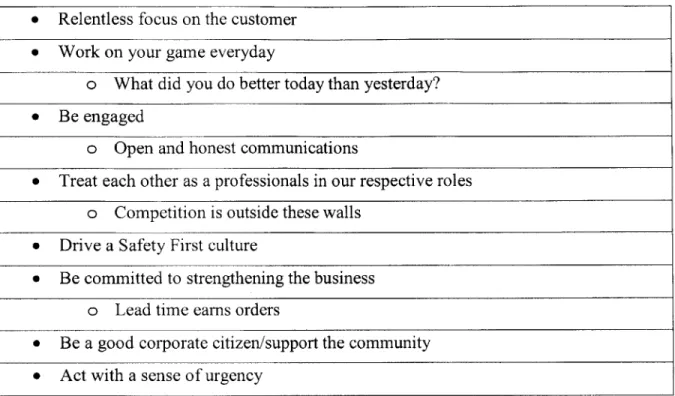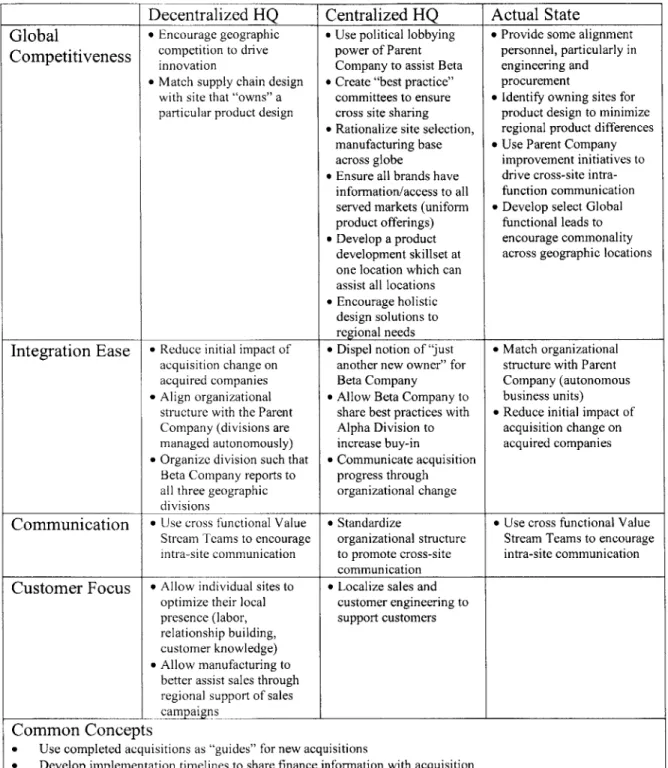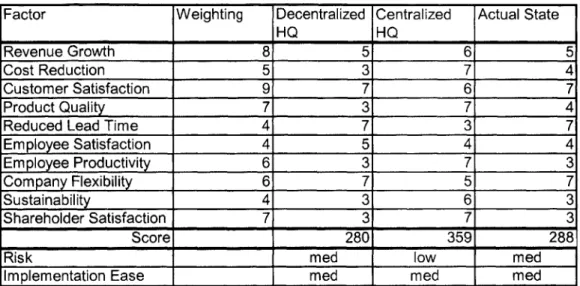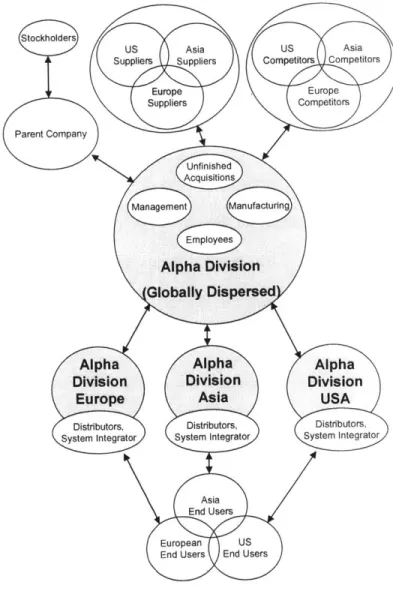Applying Enterprise Architecting to the Business Acquisition Process by
Christopher Vernon Porter
Bachelor of Arts in Business Management, Whitworth College (1996) Bachelor of Science in Mechanical Engineering, University of Washington (1996) Submitted to the Engineering Systems Division, and the Sloan School of Management in partial
fulfillment of the requirements for the degrees of
Master of Science in Engineering Systems and Master of Science in Management
In conjunction- with the Leaders for Manufacturing Program Massachusetts Institute of Technology
June 2007
C 2007 Massachusetts Institute of Technology. All rights reserved.
-~ A
Signature of Authc
MIT Sloan School of~anagement and Engineering Systems Division May 1 1 , 2007
Certified by
Deborah Nihtingale,-hesis Supervisor Professor of the Practice, Engineering Systems Division and Devartment of Aeronautics and Astronautics
Certified by
Accepted by
Accepted by
AS INs7rFUTE
JL0
2
2007
Jan Klein, Thesis Supervisor Senior Lecturer, Operations Management, Sloan School of Management
Debbie Berechman, Executi e Director of Masters Program MIT Sloan School of Management
Prof. Richard de Neufville, Professo ngineering Systems, Chair, Engineering Syst ivision Education Committee r
Disclaimer: The opinions and conclusions contained herein are solely the author's and should not
be attributed to any third parties.
Applying Enterprise Architecting to the Business Acquisition Process
by
Christopher Vernon Porter
Submitted to the Engineering Systems Division and the MIT Sloan School of Management on May 11th, 2007 in Partial Fulfillment of the
Requirements for the Degrees of
Master of Science in Engineering Systems and
Master of Science in Management
Abstract:
Background: Since the 1980s, the pace and dollar value of acquisitions in the US have
grown at an astounding rate (Hitt, Sirower). The benefits from many of these acquisitions are elusive, with 60% of recent acquisitions showing negative return for the acquiring company (Hitt et. all, 5). Expected synergies are not realized despite the valiant efforts of the integration team who struggle with implementing the plans developed prior to deal close. Correlations can be drawn to the field of systems engineering, where specific processes and tools are employed to understand the interactions of various functional areas
and avoid such implementation difficulties. Enterprise Architecting (EA) is one such framework that has shown promise in analyzing complex enterprises.
Results: The thesis shows that all currently analyzed aspects of a potential acquisition are
evaluated if the EA framework is used. It also shows that enough information is available prior to closing to use the EA framework to understand the potential enterprise. Further, it
shows that the EA framework is flexible enough to accommodate the unique aspects of an acquisition analysis. Finally, the thesis shows a definite qualitative benefit from applying the EA framework.
Conclusions: Despite the fact that one of the aspects of the hypothesis was not met, EA is
still a valid and beneficial framework to apply to the acquisition process. It provides a sound process framework that should be used to design and implement robust acquisition analysis processes. This will enable greater process efficiency, quality, and consistency.
Thesis Supervisor: Deborah Nightingale
Title: Professor of the Practice, Engineering Systems Division and Department of Aeronautics and Astronautics
Thesis Supervisor: Jan Klein
Title: Senior Lecturer, Operations Management, MIT Sloan School of Management Systems Division Education Committee
Acknowledgements:
The author would like to recognize and thank all those who have contributed to the project and to the research documented in this thesis.
I would like to give thanks to the company that sponsored this internship for their
continued support of the Leaders for Manufacturing program. To my project champion, you showed courage when many other leaders might have chosen not to get personally involved. You single-handedly made this internship possible. My project supervisor and their peers all provided me with invaluable knowledge on the acquisition process. Without your efforts, this project would never have been successful.
I would like to give special thanks to the leadership of the organizations involved in the
case study. Your employees provided me an open and honest assessment of each organization prior to the acquisition. The case study would have lacked depth and been non-conclusive without this deeper understanding of the inner workings of each company. Thanks are also owed to Jan Klein and Debbie Nightingale, my trusted academic advisors. Your guidance kept this project on track and allowed me to learn even more about myself than I learned about the acquisition process.
Finally, the author gratefully acknowledges the support and resources made available to him through the MIT Leaders for Manufacturing program, a partnership between MIT and major U.S. manufacturing companies.
Dedication:
For a married man with two young children, the decision to go back to school after almost ten years in the workplace is not made alone. I am blessed to have an incredibly
understanding wife and fantastically supportive children. Without their constant support, this adventure would never have happened.
This thesis is dedicated to our children, Corbyn and Joe. As parents, we fully recognize that the costs of their father's time and attention required for a program like LFM is a sacrifice that the kids were in no real position to understand or appreciate when they granted their approval. It is our sincerest hope that this experience will show the benefits and value of hard work and dedication to achieve personal goals. We know you will both achieve great things in life.
And, of course, this thesis is dedicated to my wife, April. As hard as this two years has been academically, the challenges of maintaining a cohesive family through the relocations and complete change in your husband's lifestyle are much greater. You are an amazing woman.
Table of Contents
1 Introduction...13
1.1 Thesis Overview ... 14
1.1.1 Problem Statem ent ... 15
1.1.2 Hypothesis... 15
1.1.3 M ethodology of Research ... 16
1.1.4 Conclusions ... 17
2 Project Description... 19
2.1 Acquisition Process Overview ... 19
2.2 M otivation- W hy is this a system s problem ?... ... ... ... ... . . 20
2.2.1 Increasing complexity of an organization that grows through acquisition ..22
2.3 Enterprise Architecting Background... 23
2.3.1 The EA Process ... 24
2.3.2 Custom ization of EA ... 27
2.4 Acquisition Process Considerations... 27
3 Project Approach ... 31
3.1 V erification of EA 's full inclusion of current process ... 31
3.2 Choosing the case study... 32
3.3 Applying EA to the case study... 32
3.3.1 Enterprise boundary definition... 33
3.3.2 Strategic Drivers and Objectives... 37
3.3.3 Stakeholder Analysis... 41
3.3.4 Current State Enterprise Architecture ... 46
3.3.5 Future Vision... 64
3.3.6 Creation of M ultiple Potential Future State EAs ... 70
3.3.7 Down-select Process for Future State EAs ... 74
3.3.8 Final Future State EA ... 76
4 Project Results... 85
4.1 Beta Com pany / Alpha Division Case Study Results ... 85
4.1.1 Organizational Structure Tension ... 85
4.1.2 Sales Channel Opportunities... 87
4.2 Hypothesis disproved? ... ... . . 88
4.2.1 A cquisition Process Im provem ents... 89
4.2.2 Recom m endation for Further Evaluation... 91
5 Thesis Im plications for M ajor Stakeholders ... 93
5.1.1 Business Developm ent Organizations ... 93
5.1.2 Enterprise Architects... 94
5.1.3 System s Engineering... 95
List of Figures
Figure 1: Enterprise Architecting Framework (Nightingale and Rhodes, 14)...27
Figure 2: Stakeholder Map- Alpha Division and Beta Company ... 44
Figure 3: Beta Company Process Map... 54
Figure 4: Alpha Division Process Map ... 56
Figure 5: Vision Statement for Asian Joint Venture... 67
Figure 6: Alpha Division Europe Vision and Values Statement... 68
Figure 7: Alpha Division Employee Values ... 69
Figure 8: Proposed Future State Stakeholder Map ... 86
List of Tables
Table 1: EA Fram ework Creation Tim eline... 29
Table 2: EA Inclusion of Current Process Synergy Identification...32
Table 3: Functional Department Process Efficiency Matrix -Beta Company...55
Table 4: Functional Department Process Efficiency Matrix - Alpha Division ... 56
Table 5: Proposed Future State EA s ... 73
1 Introduction
Since the 1980s, the pace and dollar value of acquisitions in the US have grown at an astounding rate. The benefits from many of these acquisitions are elusive, with 60% of recent acquisitions showing negative return for the acquiring company (Hitt et. all, 5). Further complicating matters, this frenzied pace of acquisition has made evaluating the corporate fit of potential acquisition more difficult; both the company looking to make the acquisition and the target company may have recent acquisitions that have not been fully integrated. Even more challenging are the complications surrounding evaluation and integration of the increasing number of companies with global manufacturing operations
and sales departments.
In light of this, stakeholders are hungering for stronger acquisition evaluation tools and techniques that will provide more confidence in the prospective benefits derived from a potential acquisition. Today, the process of evaluating a company or business for a potential acquisition is more of an art than a science. Furthermore, while "the numbers" for an acquisition have been the focus of most of the research on acquisition methodology to date, it is widely recognized that the softer side of the acquisition can have equal or more impact on the overall effectiveness of integrating the acquired company.
Similar challenges have been experienced by engineering firms tasked with understanding and developing solutions to ever more complex systems engineering
problems (Nightingale, 1). Saddled with evaluation frameworks that force rigid definitions between the system's interfaces, new concepts were created that allowed for more holistic evaluations. These concepts have been further refined into the emerging field of Enterprise
Architecting (EA), which seeks to apply the same analytical rigor used in systems engineering applications to understand the complex inner and outer workings of
enterprises: complex groups of organizations that work together toward a common goal. The concepts have shown tremendous promise in aerospace, transportation, and power generation applications. It is the author's supposition that similar frameworks that have been so successful at analyzing existing enterprises will provide significant benefit compared with current methods when applied to analyzing potential enterprises; enterprises that would exist if the acquisition is completed.
It is the goal of this thesis to verify the applicability of EA to the acquisition process. This will be done by verifying that all elements analyzed in the current acquisition process are covered by the EA framework, exploring any modifications to the framework that may be required as applied to acquisitions, and providing a case study of the application of EA to a recently completed acquisition to show its viability.
1.1 Thesis Overview
This thesis is divided into five main sections. The first section is devoted to outlining the thesis itself. The second section provides background on the acquisition process and the EA framework. The third section walks the reader through the EA framework by providing an overview of each specific analysis, information on how that analysis should be modified to apply to an acquisition evaluation, and an example of an analysis performed on a case study. Section four focuses on the lessons learned for the case study and the internship sponsoring organization. Section five covers the applicability of EA to the acquisition process itself and defines areas of future research.
1.1.1 Problem Statement
While the frequency, size, and complexity of acquisitions all continue to grow at an impressive rate, market confidence in the success of acquisitions remains dismally low (Sirower, Pablo and Javidan, Hitt). Research shows that market response upon the
announcement of an acquisition warrants a positive response only 35% of the time, and that the average magnitude of stock prices' negative reaction to acquisitions is growing each decade (Sirower, 146). Many theories have been produced to explain the growing difference in enthusiasm between management and shareholders for acquisitions, ranging from management's hubris to management pursuing personal objectives such as empire building (Sirower, 11).
The problem lies in executives' expectations of synergies that historically have not materialized, history shareholders apparently remember all too well. Firms need to
increase the accuracy of their synergy calculations and better account for the non-monetary elements of the acquisition that are required to capture hoped for synergies. Increased
accuracy of synergy identification will increase shareholders faith in management's acquisition decision making skills and reduce the expectation gap between these two key stakeholder groups.
1.1.2 Hypothesis
The hypothesis for this thesis is that EA is applicable to the acquisition process. Four conditions will be examined to test EAs applicability.
1. Verify that all elements analyzed in the current acquisition process are covered by the EA framework
2. Explore any modifications to the framework that may be required as applied to acquisitions
3. Provide a case study of the application of EA to a recently completed acquisition
4. Demonstrate an added benefit from applying the EA framework, as compared to current methods
1.1.3 Methodology of Research
This project was completed in the Business Development organization at a large, diversified corporation, hereafter referred to as the Parent Company. The research and case study analysis were performed at the Parent Company facility between October 2006 and February 2007.
First, the author reviewed relevant literature and interviewed the Parent Company's Business Development employees to determine the current state process used to evaluate and plan for the integration of acquisitions. The current process was mapped with specific attention paid to the types and depth of information available at different times in the current acquisition process.
Second, the Parent Company identified a recently completed acquisition where pre-acquisition information about the acquired companies was available. This information, along with information provided by the affected portions of the Parent Company and personal interviews, was used to perform an EA analysis. This analysis was used to
identify any benefits of applying EA to the acquisition/integration process and to ensure all portions of the current acquisition process were represented within the EA framework.
Finally, the case study and process of evaluating an acquisition using EA were used to evaluate the effectiveness of applying EA to the acquisition process.
In order to ensure that the author's analysis does not disclose any proprietary information of the organizations involved, it was decided to mask all identifying
information about the Parent Company and all divisions therein. Identifying information for the acquired company is also disguised. Thus, the case study analyzes the Alpha Division of Parent Company and it's purchase of Beta Company. Other divisions of the Parent Company are called Kappa Division and Delta Division. Brand names are disguised as Tough Pump, Power Pump, and Europump. All related mission statements and company histories have also been modified by the author to convey the original intent while disguising the originating companies.
1.1.4 Conclusions
The first three conditions for proving the hypothesis for this thesis were met. All elements currently associated with the acquisition process are included in one of the analyses required as part of the EA framework. Suggested modifications to the EA framework consisted only of minor changes in emphasis across different elements. Finally, the EA framework was successfully applied to the case study and provided areas of potential benefit.
The fourth condition was, in the author's opinion, only partially met. Numerically quantifiable results would have highlighted the increased effectiveness of applying EA to acquisition studies. The case study did not identify quantifiable benefits. The case study did identify changes in the organizational structure and the value creation process that would yield benefits to the acquiring and target organizations. It also identified benefits in the acquisition process relating to increased opportunities within the acquiring and target organizations for documentation, communication, collaboration, and integration. It is the
author's opinion that EA definitely shows a positive benefit where applied to the acquisition process, regardless of the lack of quantifiable improved results.
2
Project Description
2.1 Acquisition Process Overview
For firms that grow through acquisition, the proprietary acquisition process they follow
is often considered a competitive advantage. An entire industry of consulting, legal, and banking firms has developed to assist firms in developing strong acquisition skills. While different firms may approach acquisition and integration evaluation slightly differently, all follow a relatively generic process flow, which is detailed below:
* Target Acquisition. A potential acquisition can be identified in a multitude of
ways, ranging from an announcement of the intent to sell to the culmination of a long courting process, during which an acquiring organization may work for years to entice the target to sell. A target will usually exhibit some quantifiable synergy in order to be considered fully.
* Target Profile Creation. More information on the target is generated by combing
publicly available sources of information (annual reports, industry assessments, periodicals, target company data packages, etc.). Known synergies as well as target bid prices should be identified and developed.
" Due Diligence: Detailed information on the target company is gathered by a small
team of specialists to verify previously gathered information and confirm/expand expected synergies and identification of risks. Target bid prices should be refined.
" Negotiation. Given the expected synergies and risks, negotiations between the two
I
Jntegration: The target company should be integrated into the acquiring company
per the plan developed throughout the rest of the process.
2.2 Motivation- Why is this a systems problem?
Many managements apparently were overexposed in impressionable childhood
years to the story in which the imprisoned handsome prince is released
from
atoad's body by a kiss from a beautiful princess. Consequently, they are certain their managerial kiss will do wonders for the profitability of Company T(arget).
Such optimism is essential. Absent that rosy view, why else should the shareholders of Company A(cquisitor) want to own an interest in Tat the 2X takeover cost rather than at the X market price they would pay if they made direct purchases on their own?
In other words, investors can always buy toads at the going price for toads. If investors instead bankroll princesses who wish to pay double for the right to kiss the toad, those kisses had better pack some real dynamite. We've observed many
kisses but very few miracles. Nevertheless, many managerial princesses remain
serenely confident about the future potency of their kisses - even after their
corporate backyards are knee-deep in unresponsive toads.
- Warren Buffett, 1981 Berkshire Hathaway Annual Report
This obsession with kissing many toads, hoping to find a prince, is a driving force behind US business and continues to strengthen despite numerous studies that suggest
these kisses destroy, not create, value for the acquiring organization. The magnitude of merger activity is impressive; the last decade of the twentieth century brought about $12 trillion in global acquisition activity (Picot, 4). The number of acquisitions that show a positive return on investment is conversely unimpressive; Business Week reports that recent acquisitions destroyed value for the acquiring company 61% of the time (Henry,
60).
Parallels can be drawn to engineering systems where system performance has similarly trailed expectation. Engineering systems have become increasingly complex as firms drive to push technological limits, create more integrated products, and employ globalization strategies. Boundaries between different engineering specialties are often considered inflexible to simplify analyses. Expectations for system-level performance are often overestimated due to a lack of understanding on how individual systems will
integrate with one another. Engineered systems have addressed these challenges by implementing Systems Engineering, a discipline devoted to managing the interfaces between disparate functional areas. The fundamentals of systems engineering have also been applied to designing and analyzing complex organizations as part of EA.
The most basic definition of synergy implies that the whole is greater than the sum of the parts. Within any one aspect of a company, management and employees alike will try to maximize the efficiency of their own organization. It is unlikely that new
management will uncover vast untapped value that the previous organization did not find on the micro level. Instead, it is the combination of the acquiring and target company that typically represents the opportunity to create additional value. In short, it is at the system level where the greatest benefits of an acquisition should be found.
Yet the acquisition process analyzes the target company primarily at the micro level. Individual subject matter experts are called to participate on due diligence teams to understand and evaluate their areas of expertise in the target company. Each is armed with
a series of questions that are designed to fully understand their particular area and minimize risk for the acquiring organization. Due diligence is frequently very
concentrated with little time devoted to allow subject matter expert to share the unique aspects of his or her analysis. One individual, typically someone with experience in acquisitions leading the due diligence team, may be the only person tasked with identifying and developing system-level solutions. The degree to which system-level solutions are identified and evaluated is very dependant on the skills of this due diligence team leader. It is the author's supposition that many of the opportunities and risks associated with a potential acquisition may be hidden across these functional boundaries and that a more holistic analysis of the potential acquisition would provide a much more accurate estimate of the potential synergies.
2.2.1 Increasing complexity of an organization that grows through acquisition
The challenges faced when evaluating an acquisition grow increasingly complex when there are previous acquisitions that must be taken into account. Acquisitions that have been purchased but not fully integrated affect acquiring firms in multiple ways:
" Resources required to evaluate and integrate acquisitions may be stretched thin " Unfinished acquisitions add an additional level of uncertainty when evaluating
potential new acquisition synergies, since the acquiring organization is in a more pronounced state of flux than usual
" Opportunities to identify lessons learned in the previous acquisition might be lost when resources and personnel are shifted to integrating the latest acquisition
" Risks that were considered minor in probability or consequence for previous
acquisition might compound leaving the entire organization more vulnerable.
2.3 Enterprise Architecting Background
EA is a holistic, systems-level approach to analyzing, understanding, and improving
the interaction and design of complex groups of stakeholders. At its core, EA is a framework that allows individuals or teams to distill these complex relationships into smaller, more manageable analyses without losing the opportunity for system-level benefits. EA has been successfully applied to a number of complex existing enterprises ranging, from academic programs to defense contracting organizations. However, it has not yet been applied to an acquisition process where the goal is to analyze two distinct organizations that are combining into one.
It is helpful to break the term Enterprise Architecting apart to understand each of its' components separately. Enterprise is best defined as "complex, highly integrated systems comprised of processes, organizations, information and supporting technologies"
(Nightingale and Rhodes, 2004). The concept of examining companies as enterprises is not new and has been studied extensively by management and social scientists.
Architecture, as applied to complex systems, can best be defined as "the fundamental organization of a system embodied in its components, their relationships to each other and to the environment and principles guiding its design and evolution" (IEEE P1471).
Combining these two concepts together creates a powerful ideology that can assist enterprise leaders in the thoughtful design and execution of their mission.
2.3.1 The EA Process
An EA is created through a series of analyses. They are:
1. Enterprise Boundary Definition 2. Strategic Drivers and Objectives
3. Stakeholder Analysis
4. Current State Enterprise Architecture 5. Future Vision
6. Creation of Multiple Potential Future State EAs 7. Down-select Process for Future State EAs
8. Final Future State Architecture
Each is described in more detail in the following sections:
2.3.1.1 Enterprise Boundary Definition
Enterprises commonly involve complex organizations. It is beneficial to limit the scope of what portion of these organizations is analyzed to simplify the analysis and allow for more research depth into each area. However, limiting scope must be balanced against the need to analyze as much of the organization as possible, which can identify more
system-level synergies. Clearly delineating what organizations and stakeholders are included in the analysis is an important step to ensure all participants are aligned.
2.3.1.2 Identification of Strategic Drivers and Objectives
Understanding what strategic drivers and objectives exist in the market space where the enterprise operates is crucial in determining how an enterprise should position itself. This portion of the EA should document the macro-level strategic considerations for the enterprise. It is crucial to understand the potential industry earnings, nature of
competition, availability of substitutes, power within the vertical supply chain, and barriers to entry. It is important to note that this portion does NOT plan a response to this macro-level strategic information.
2.3.1.3 Stakeholder Analysis
The stakeholder analysis documents all affected entities of the defined enterprise and the nature of their interactions. It can highlight underserved stakeholders who may disrupt planned changes if they have ability to do so. For acquisitions, the stakeholder maps visually present differences in stakeholder relationships between the two
organizations that will need to be addressed.
2.3.1.4 Current State Architecture
EA is defined by seven distinct views: Policy / External Factors, Strategy, Process,
Organization, Knowledge, Information Technology, and Products / Services. The different views are defined separately, yet influence each other to create a holistic understanding of the analyzed enterprise. For acquisitions, the views are developed separately for the target
and acquiring organizations.
2.3.1.5 Future Vision
The future vision documents the intended strategy and mission of the combined enterprise. It is the guiding light that governs the intended output from the future state architecture. To this end, it also serves as the evaluation tool to discriminate between various different future state architectures based on difficulty of implementation and the degree to which they fulfill the future vision.
2.3.1.6 Creation of Multiple Future State EAs
Throughout the creation of the previous EA sections, it is inevitable that potential enterprise improvements will be identified. At this stage, these ideas should be
documented and grouped into holistic enterprise solutions. It is important that these ideas are grouped based on their system synergies to create integrated solutions.
2.3.1.7 Down-select Process for Future State EAs
With the creation of multiple potential future states, a process to choose the optimum solution is required. Based on the end state defined by the Future Vision, different attributes can be defined and given numeric weighting based on their relative importance. The down-select process should also include risk assessment and ease of implementation as compared with the defined current state architecture. Numeric synergy calculations can also be completed at this stage. The end goal is to choose one, final future
state to further refine.
2.3.1.8 Future State Architecture
Using the same seven views that document the current state architecture, the future state architecture captures the intended future state for the combined enterprise. This document serves to align the implementation team and fully defined the expected system synergies.
2.3.1.9 EA Framework
It is important to stress that enterprises can't be dissected and analyzed in parts. It is within the interaction of each of these pieces that system level synergies can be found.
A framework for how these views fit with each other is included as Figure 1 (Nightingale
p. - - S
-Figure 1: Enterprise Architecting Framework (Nightingale and Rhodes, 14)
2.3.2 Customization of EA
For many elements of EA, there are multiple analysis frameworks and techniques that can be used to document and describe the relevant information. This thesis captures the author's preferred methods, but they are not intended to dictate a preferred analysis
framework. The value of EA lies primarily in that each portion is analyzed, documented, and integrated with all of the other sections. If a particular EA participant has a favorite method for analyzing and describing a particular EA element, that method should be used.
2.4 Acquisition Process Considerations
While EA has been used extensively to analyze existing enterprises, it has not been used to evaluate an enterprise that does not yet exist. Using EA to evaluate two separate corporate entities that are looking to become one requires a certain amount of special
Pr-d1-- s / w ro e
I
-~ a EU Iconsideration. Issues such as the timing of information availability from the target organization and the level to which reliable target information is available prior to the purchase can have an impact of the overall quality of the analysis.
Gathering the information required to complete an EA is challenging even in organizations that are interested and eager to work toward a common future vision.
Accessing information from the target company is an order of magnitude harder for several reasons. First, the target company has an incentive to provide only positive information to the acquiring company in order to increase negotiation leverage. If too much of the
analysis is completed based on this overly rosy information, the future state architecture will fail to address many of the areas of opportunities within the target firms. Secondly, the target firm understandably limits the amount of information they share with potential acquiring firms based on the stage of the acquisition process, particularly if it points to increased risks.
Consideration for when data would be available to complete the EA led to the creation of Table 1. This figure highlights when various sections of the EA can be reliably created based on the information available. Given the restriction of data from the target organization, it is expected that several sections will need to be revisited after deal closing in order to reduce the risk inherent from false information. These elements are denoted with a "II" to indicate review and revision as required.
Target Indication of Due Purchase
Profile Interest Diligence Decision Integration
Organization Enterprise Future Organization
Boundary Process View
View Vision View II
Definition
Product / Information
Stakeholder Future State Future State
Services Analysis Technology EAs EA 11
EA Process View View
Implementation Strategic Down-select
Strategy to Final Strategy View
Drivers and t ia
View II
Objectives Future State
Knowledge Knowledge
External /
Management Management
Policy View
View View 11
Table 1: EA Framework Creation Timeline
3
Project Approach
3.1 Verification of EA's full inclusion of current process
EA could not be considered for replacement of existing acquisition evaluation
processes if it did not capture all of the benefits currently identified. Major sources of potential synergies were mapped into the EA framework to ensure all current potential synergies would be captured using EA to evaluate an acquisition. The results are shown in Table 2. Note that potential areas of synergy were mapped into the section of EA where they would mostly likely be discovered. Most potential synergies have benefits and costs
in multiple areas within EA.
EA View Framework Potential Synergy
Policy / External Factors View 9 Governmental policy changes
Strategy View 9 Access to capital
* Strategic vertical supply chain
considerations
Process View e Employee reduction due to redundant
departments
9 Improved access to markets
Organization View 9 Production facility rationalization * Economies of scale
Knowledge View 9 Intellectual property
Information Technology View * Improved technology use
Products / Services View 9 Leveraging brand equity to new product
" Bundling opportunities within product lines
" Complementary products Table 2: EA Inclusion of Current Process Synergy Identification 3.2 Choosing the case study
There were several key factors in selecting a case study. Given the sensitive nature of an active acquisition, it was decided to use a recently completed acquisition for a trial application of EA fundamentals to an acquisition. The chosen acquisition had several defining characteristics:
" Recent enough that stakeholders would remember what the two organizations were
like just prior to the deal close
* Considered successful by most everyone involved in order to foster the open sharing of information
* Have limited company-sensitive information to make data collection and public sharing (i.e., a publishable thesis) easier
The chosen acquisition was the mid 2000 purchase of Beta Company by the Alpha Division Corporation; a business unit within the Industrials Division of the Parent Company.
3.3 Applying EA to the case study
Once the case study had been identified, information on the acquiring and target organizations was gathered by reviewing documentation created during the acquisition process, as well as conducting extensive personal interviews with personnel at Beta
analyze enterprises that were currently separate but that might be combined in the near future. Each component of the EA framework was carefully considered given this new application. There are three primary sections presented for each of the EA components:
" Overview: Each EA component and its importance are discussed in detail to
provide the reader more background.
" Acquisition Process Implications: Specific considerations or slight modifications
to the framework are analyzed and presented.
" Alpha Division - Beta Company Case Study: An example of the component as
it would be applied to the case study is presented.
3.3.1 Enterprise boundary definition
3.3.1.1 Overview
Before an Enterprise can be carefully analyzed, it must be carefully defined. If the enterprise is defined too broadly, either the analysis will consume inordinate amounts of resources (both calendar time and man hours) or it will not have enough depth to fully
identify all of the relevant issues and their potential solutions. Alternatively, if the system is defined too narrowly, system-level benefits that extend beyond the set boundaries will not be identified and developed. There is a direct trade off between the costs of analyzing a broad enterprise and the risk of missing opportunities associated with a narrower
enterprise definition.
3.3.1.2 Acquisition Process Implications
Enterprise definition helps the acquisition process by narrowing the portion of the acquiring company that needs to be considered. For multi-faceted companies, the portion
of the firm that is pursuing the acquisition is most involved with the synergy analysis. They may be supported by a central business development group that makes sure synergy opportunities in other areas of the business are identified and developed. The process of formally documenting the enterprise boundaries should help define the analysis team and make sure that all potential stakeholders are identified and become involved early in the process.
3.3.1.3 Alpha Division - Beta Company Case Study
For the Beta Company Acquisition, enterprise definition was relatively straightforward. There were two specific portions of the enterprise that needed to be defined: how much of Beta Company and how much of Alpha's Parent Company to include in the enterprise analysis. After careful consideration, it was determined that only the Alpha Division portion of Parent Company and all of Beta Company would be
included in the analysis. An explanation of this decision is detailed below.
3.3.1.4 Beta Company Boundaries
It would be unusual for an acquiring company not to include the entirety of the target company, or the specific division within a company that is available for sale, in its analysis. There may be a circumstance in which this is not the case; for instance when the target organization has a division that does not have a strategic fit with the rest of the business and is an obvious candidate for divestiture. For Beta Company specifically, there were no obvious immediate divestiture opportunities. Therefore, all of Beta Company was included.
3.3.1.5 Parent Company Boundaries
The decision about what portion of Parent Company to include in the analysis also proved to be relatively straightforward. Given the products Beta Company produced and
the markets they served, it was obvious at the outset that the Beta Company acquisition would have little to no synergies with other division within Parent Company outside of Parent Company's Industrials division. Within Industrials, there are three completely autonomous divisions: Alpha, Kappa, and Delta. Each was evaluated separately for inclusion in the enterprise analysis.
Alpha Division: The author's synthesis of Alpha Division's website is included below: Since early in the 1900's, Alpha Division has used its scientific, engineering and production resources to develop and manufacture equipment that accurately controls fluids ranging from water to high viscosity polymers, damaging chemicals, caustic substances, and other challenging pumping media.
Alpha Division also makes safety valves, back pressure valves, calibration columns, pulsation dampeners, and streaming current detectors, as well as tanks and chemical feed systems. Alpha Division has three main geographically delineated business units: Alpha Division Asia, Alpha Division Europe, and Alpha Division USA.
Alpha Division was the business division requesting the purchase of Beta Company. While there were some Beta Company products that complemented or
overlapped the existing Alpha Division product line, specifically Beta Company's Tough Pump line, the request to pursue the acquisition was not based on complementary product
offerings (filling gaps in the Alpha Division product offerings). Instead, the expected synergies with Alpha Division existed in the distribution and sales channels, mainly the extensive development and use of strong, tier one distributor networks in the US. With
approximately 800 employees, Alpha Division was small enough to include in its entirety in the analyzed enterprise.
Kappa: Kappa Division offers reliable compressed air products for a variety of different applications and supports all its solutions with high-quality parts, services, and training. Kappa Division's primary products include industrial air compressors, dryers, filters, construction air compressors, air tools, and air end units (system level solutions). While Beta Company produced some amount of gas boosters and air pressure amplifiers, they were not of the air volume and continuous duty usage of typical Kappa Division offerings. Furthermore, there were few synergies in either the supply base or distribution and sales networks. Given this, it was decided Kappa Division would not be included in the analysis since there was little chance synergies would be found between Beta Company and Kappa Division.
Delta Division: The author's synthesis of Delta Division's website is included below: Delta Division designs, manufactures and supports industrial pumps and compressor products, primarily for the process fluid and gas industries. Delta Division's primary markets are worldwide hydrocarbon and chemical processing, pulp and paper, power
generation, and the food and beverage markets. Aftermarket services include spare parts, overhaul and repair as well as engineering and technical support.
Delta Division and Alpha Division have an intermixed history and at one point were combined into one division. After three years of operating as one business unit, customer confusion surrounding product offerings and global distribution concerns became more costly than the savings provided by the synergies associated with combined operations, management, and distribution. The two companies were separated in the 1990s.
While a few of Beta Company's products had some overlap with Delta Division's offerings, the applications (flow rates, price points) were significantly different. Given the vastly better fit with Alpha Division and the limited potential for system-level synergies, Delta Division was also excluded from the scope of this enterprise analysis.
3.3.2 Strategic Drivers and Objectives
3.3.2.1 Overview
In order to create and maintain a competitive advantage, a firm must have an idea of what macro-level strategic drivers are affecting the industry the firm serves.
Understanding an industry's potential industry earnings, industry barriers to entry, power distribution in the vertical supply chain, and the nature of competition are all key factors to evaluating an industry's attractiveness. Defining these variables is required before the impact of a potential acquisition can be evaluated.
3.3.2.2 Acquisition Process Implications
For the acquisition process, strategic drivers and objectives should be identified separately for the acquiring and the target company, provided they serve different industries. The different organizations may have common strategic drivers and similar objectives, making it easier for different stakeholders to understand what will drive the enterprise after integration. Alternatively, the organizations might have strategic drivers that are counterbalancing, providing risk mitigation for both institutions. Understanding these drivers prior to acquisition will help the organization determine how they will change after the acquisition is finalized; a key factor in determining how the new enterprise will perform.
3.3.2.3 Beta Company
Potential Industry Earnings: In the US and Europe, Beta Company sold into mature markets with deeply established personal relationships between independent distributors
and end customers. Given that Beta Company's products were a very small portion of a much larger system, customers were generally willing to pay more for a higher perceived quality product. The potential market for Beta Company's products was expected to grow along with the markets that it served; there were no expected new applications of its products and no increased consumption expected from current markets. There were few, if
any, product substitutes for Beta Company products in these markets. Given this potential revenue curve, the market was experiencing more pressure on cost in order to maximize potential earnings.
In other international markets, Beta Company was experiencing much faster growth serving the same types of industries as the US. Relationships within these markets were not as established given the high number of new entrants and the less mature nature of the industry. Beta Company was able to sell directly to these consumers, which helped it
establish the same high-quality reputation the company enjoyed in the US and Europe. Given the increased revenue growth potential, cost pressures were not as high in international markets.
Threat of Entry: In the US and European markets, established relationships acted as a significant barrier to entry. With less established international markets, new entrants were more of an issue. To help establish these relationships quickly, Beta Company would partner with existing independent distributors early and help them build their local markets. As the distributors grew to sufficient size, Beta Company would purchase the
distributors in order to own the customer relationships. Increased competition in international markets drove minimal price competition.
Rivalry: There was not intense competition between Beta Company and its competitors, as evidenced by little price competition and the generally slow rate of product development. There were few major players competing based on perceived quality. As mentioned
earlier, the markets were willing to pay a premium for higher quality products and services. Vertical Market Power: The components going into Beta Company's products were generally commodities, which provided very little market power to the suppliers. In the
US and Europe, independent distributors held considerable market power given their close
relationships with the customers. This was tempered somewhat by the close relationships these distributors also had with Beta Company; no distributor had ever dropped Beta Company's product line. Although switching costs were relatively low, customers in general accepted the distributor's suggestions given the low relative value of the product.
3.3.2.4 Alpha Division
Potential Industry Earnings: Alpha Division experienced nearly identical industry earnings considerations as Beta Company. The US and Europe had mature markets with deeply established personal relationships between distributors and end customers. Customers were generally willing to pay more for a higher perceived quality product, given the relative cost of Alpha Division's products. The potential market was expected to grow
along with the industries where the products were used; there were no expected new applications of its products and no increased consumption expected from current markets. There were few, if any, product substitutes. Given this potential revenue curve, the market was experiencing more pressure on cost in order to maximize potential revenue.
International markets were growing much faster. Most international markets had immature relationships and had many new entrants. Alpha Division used more direct sales in these markets, which helped them establish the same high-quality reputation they enjoyed in the US and Europe.
Threat of Entry: Similar to potential industry earnings, Alpha Division mirrored Beta Company when looking at the threat of entry into the industry Alpha Division served. In the US and European markets, established relationships acted as a significant barrier to entry. With less established international markets and a less established brand name for quality, there were few barriers to entry. Increased competition in international markets drove some amount of price competition. It is important to note that there were some customers that were common across many of Alpha Division's global markets. Rivalry: Similar to Beta Company, there was not intense competition between Alpha Division and its competitors, as evidenced by little price competition, a limited number of companies serving these markets, and the generally slow rate of product development. As mentioned earlier, the markets were willing to pay a premium for higher quality products and services.
Vertical Market Power: The components going into Alpha Division's products were generally commodities, which provided very little market power to the suppliers. In the
US and Europe, independent distributors held considerable market power given their close
relationships with the customers. Although switching costs were relatively low, customers in general accepted the distributor's suggestions given the low relative value of the
3.3.2.5 Alpha Division - Beta Company Analysis
A few key observations not noted in the proceeding section merit further clarification. - Alpha Division's and Beta Company's strategic drivers and position within their
markets were very similar.
- There did not appear to be any offsetting cyclical demand pattern advantages with the merger.
- The acquisition would allow Alpha Division to serve other facets of markets where they already had a presence and would almost double the company's distribution and
sales networks in the United States.
- Alpha Division had a stronger international presence and would be able to facilitate the growth of Beta Company products in international markets better than other competing bidders.
3.3.3 Stakeholder Analysis
3.3.3.1 Overview
The most concise definition for a stakeholder as applied to EA comes from Ignacio Grossi; a "stakeholder is any group or individual who directly or indirectly affects or is affected by the level of achievement of an enterprise's value creation process" (Grossi, 29). Understanding who will be affected by a change at the Enterprise level is crucial to both determining the optimal EA to accomplish the change and uncovering stakeholder resistance that might thwart change efforts. Furthermore, the stakeholder maps can be used to evaluate cultural fit; the more differences between stakeholder relationships for the two organizations, the more difficult the change will be if one organization needs to conform to the other.
3.3.3.2 Acquisition Process Implications
Although the rest of the current state enterprise analysis methodology is completed independently for the acquiring and target organization, stakeholder maps are better drawn with the two organizations shown together. This simplifies the identification of common stakeholders. These maps will be used both to help determine the magnitude of cultural change within each organization and to identify any stakeholders who may be stretched too thin during the integration process.
3.3.3.3 Stakeholder Map
A physical depiction of the enterprise stakeholders and how they are connected to each
other is an important communication tool among decision makers within the enterprise.
By physically delineating the stakeholder relationships, a number of key discoveries can be
easily identified and discussed. Particularly for the acquisition process, the following questions should be directly addressed:
" What stakeholders do the two organizations have in common? Is there a common
worker union? Are the product lines used by the same end users? Do the two companies share the same competitors? If there are currently few shared
stakeholders, are there any relationship synergies available?
* Are the stakeholder structures radically different between the two companies? Are there more stakeholders in one organization versus another? Are there any key stakeholders missing in one company? Could one organization adopt the other's stakeholder structure or will this cause cultural conflict?
" Are there stakeholders that seem to act as intermediaries between other
through one particular group? Can this bottleneck resource accommodate the acquisition?
A stakeholder map for Alpha Division and Beta Company is included as Figure 2. Arrows
indicate interactions between different stakeholders. The four larger circles indicate
company boundaries. It is important to note that several stakeholders straddle both sides of the circle, indicating some portion of the relationship is outside of the company
boundaries. Arrows pointing to the edge of the company boundaries indicate interactions with all stakeholders within the circle, including those that sit partially outside of the company boundary.
Suppliers Competitor
Management Unfinished Global
cquisition End Users
mployee t Compay
Distributors, Beta Company System Integrator
Unfinished
Acquisitions
Figukholdr e 2Distributors,
Management System Integrator
Alpha Division "HQ"
Alpha Div. USA
us End Users
Unfinished Asia Europe
us Asia Acquisitions End Users End Users
Competitors Competitors
Management Europe
Competitors Distributors,
System Integrator Alpha Div. Asia
us Asia Suppliers Suppliers Europe Suppliers Unfinished Acquisitions Management Distributors, System Integrator Alpha Div. Europe
3.3.3.4 Alpha Division - Beta Company Analysis
The Stakeholder Map given as Figure 2 points to a number of key observations that would require further consideration during and after the acquisition.
1. There were acquisitions in both Beta Company and Alpha Division that had not
been fully integrated. These unfinished acquisitions add another level of complexity to the acquisition analysis given the unsettled nature of the
organizations involved. Depending on the type of integration strategy, it might mean that the culture of the acquiring or target organization is in flux. It also means that management and integration resources might be strained given the volume of integrations in work. Alternatively, this also might allow a new acquisition to learn
from the on-going integration of previous companies (integration timing, lessons learned, integration mentorship).
2. Within Alpha Division, there were three separate geographic divisions that reported to the upper-level Alpha Division Company, which consisted of a President,
Engineering and Supply Chain manager, Finance Controller, and a handful of other central administration managers. Other than reporting to this central entity, each region was responsible for covering its own markets in its own manner with very little guidance / interference from the Parent Company. Beta Company covered all markets from a central headquarters. Restructuring Beta Company to have similar stakeholder relationships would require significant structural changes.
3. It was evident that the Alpha Division divisions and Beta Company shared very
few if any stakeholders. This would indicate limited opportunities for relationship-based synergies (brand recognition or increased market power relative to suppliers).
4. While the Alpha Division geographic divisions shared many of the same suppliers, competitors, and end users, they were independent entities with separate
relationships with each stakeholder. This structure should be highly effective at servicing the different geographic markets. If these markets started to move toward common end users (i.e. the three end-user circles started to overlap more), it might be more effective to have a more active central organizing entity within the Alpha Division.
3.3.4 Current State Enterprise Architecture
3.3.4.1 Overview
There are seven different "views" through which an organization should be analyzed as part of applying EA fundamentals. These views should be developed separately and then evaluated together per the framework shown in Figure 1 (Nightingale, 14).
- Policy/External Factors: Government regulation, changes in customer demographics and needs, and movements by competitors can change the environment in which an enterprise operates. Understanding these external factors in their current state and their possible future states is crucial to understanding how effectively an enterprise will perform.
- Strategy: Strategy is core for any business and is a critical component in any
acquisition decision. Understanding the current strategic business issues and priorities for both the acquiring and target firms is required before determining how the strategy will change after acquisition.
- Process: Process is the manner in which the organization creates value. It encompasses
all aspects of the organization and the ways different functional areas interact in order to provide a product or service to the customer. Understanding how well each
stakeholder groups is functioning in the overall organization helps to identify organizational synergies; for example, strong procurement skills in one organization could be used to offset weaker skills in the other.
- Organization: Functional groups should be organized in the most efficient manner to
support the process of creating value for the customer. Organization is best viewed through three lenses: Strategic Design, Political, and Cultural. The acquisition process should evaluate the different organizational structures to evaluate overall cultural fit.
- Knowledge: The knowledge view can be most closely approximated to the field of
knowledge management: defined as the processes and, to a lesser extent, the tools an organization uses to capture knowledge. The maturity of knowledge management within an organization is a critical factor in determining how information can be shared both within the current company and once the acquisition has been made. It is
important to note that the knowledge view includes the knowledge required for
employees to perform their work, the knowledge capability within each employee, and the knowledge sharing that happens within the organization.
- Information Technology: Information technology enables the process, organization,
and knowledge views of the enterprise. This would include computing and voice infrastructures, as well as any collaboration tools used.
- Products/Services: Understanding how the products and services the enterprise creates
fit into the competitive environment is key to understanding how the enterprise will perform.
3.3.4.2 Acquisition Process Implications
Having a defined, documented analysis of the underlying architecture of the organization is a critical component in determining what changes should be made in each organization and the benefits associated with each change. Documentation also serves to "level set" both the acquisition team and the integration team and allow for open debate in areas where individuals might not agree. Finally, the Current State EA is critical in determining which of the proposed future states will be easiest to implement and have the lowest risk of unintended consequences.
3.3.4.3 Policy/External Factors View
Background: An enterprise both influences and is influenced by the environment in which it operates. Understanding how this external environment will change in the foreseeable
future is a key to determining how the combined enterprise will perform. This projected performance should dictate the purchase price of the target.
Beta Company: There was very little government policy in the US that uniquely affected Beta Company. Beta Company was affected by import and export policy in the other markets it served, similar to any other company that markets and sells its product globally.
There were no plans to open production facilities in other countries. There were no significant changes in the competitive landscape that were expected to affect Beta Company's strategy.
Alpha Division: Similar to Beta Company, Alpha Division had no major government policy interactions that were significantly influencing its strategy. Alpha Division had a much stronger international presence, including manufacturing operations, which created multiple sources of government influence. There were cultural implications in Europe that
influenced where a product was produced versus where it was sold. Alpha Division, as part of Parent Company, had significant governmental lobbying power at its disposal. There were no significant changes expected in the competitive landscape that would affect Alpha Division's strategy.
3.3.4.4 Strategy View
Background: After analyzing the external strategic drivers in section 3.3.2, it is important to understand the internal strategies of the acquiring and target organizations. The strategic direction of an enterprise is the roadmap that aligns the enterprise to move toward its goals and defines how it will compete in the external marketplace. Understanding the degree of alignment between the current strategies of the two firms provides an indication of how radically one or both directions may change if the acquisition is completed. It is difficult to acheive alignment around an established strategy even when all other business factors
are steady. If the strategic direction changes, workers may loose confidence in senior management if they perceive these leaders are changing direction too often thereby
creating unnecessary and often painful change (i.e. corporate restructuring or lay-offs). The magnitude of strategic change in an organization should be accounted for when
considering future enterprise performance.
The author has chosen to analyze each organization's internal strategy using the following framework as developed by the Sloan School of Management at the
Massachusetts Institute of Technology: Strategic Objective, Strategic Scope, Competitive Advantage, Internal Consistency, and External Consistency.
